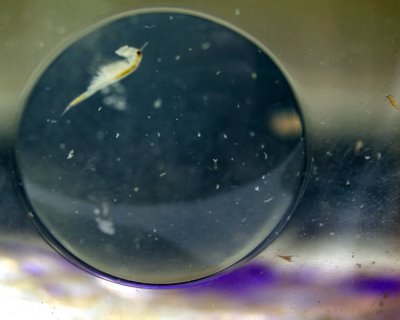Deep Sea Monkeys
Common name: Sea Monkey(Brine Shrimp)
Scientific name: Artemia salina

Description
Just over a centimeter in size, the adult sea monkey Artemia is an extremely wellknown animal because of its importance as a food source for fish and crustaceans raised in home aquariums, aquaculture systems, and in laboratories. One can buy brine shrimp at practically any pet display. It looks like a powdery brown substance but in reality the substance is thousands of cysts-eggs surrounded by protective cases.
Nature
Under magnification, the elongated shape and eleven pairs of limbs give this organism a shrimplike shape, but Artemia actually falls into an order of primitive crustaceans. Various pigments from the phytoplankton that the shrimp eats give hues of blue, green, and red to the otherwise transparent body.When the sea monkey is added to water, the cysts will hatch into shrimp nauplii within a few hours.
Lifecycle
In the United States, in areas such as the Great Salt Lake, the brine shrimp's yearlong life cycle usually begins in early spring. After hatching, the larvae will go through 15 molts before it reaches the adult form. These begin to die by October and most will be gone by December.
Reproduction
In the period from May to December females will give birth to either live nauplii or, if conditions are wrong for larvae survival, they will lay a number of cysts. These will be dispersed by winds and waves. Often the cysts drift to shore, where they remain until spring rainfalls wash them back into the water. These will later hatch when water, temperature, salinity, oxygen, and other seasonal conditions are right.
Special Features
It is this ability of the sea monkey cysts to remain dormant for long periods of time and then be easily hatched that has made them an easy live food for the use of tropical fish hobbyists and aquaculturist as well as a valuable organism for research. These cysts can withstand wide fluctuations in temperature due to their ability to lose, and regain, practically all of their intracellular water.
Uses
It has been useful to a variety of researchers in genetics, histology, toxicology, radio biology, biochemistry, molecular biology, and ecology. Because the cysts are also very small and require no food, they were chosen as test organisms for the early space experiments. Cysts housed both within and outside the U.S. Apollo and the U.S.S.R. Cosmos spacecraft helped scientists determine the effects of ultraviolet radiation on living cells.
 Deep Sea Crabs
Deep Sea Crabs